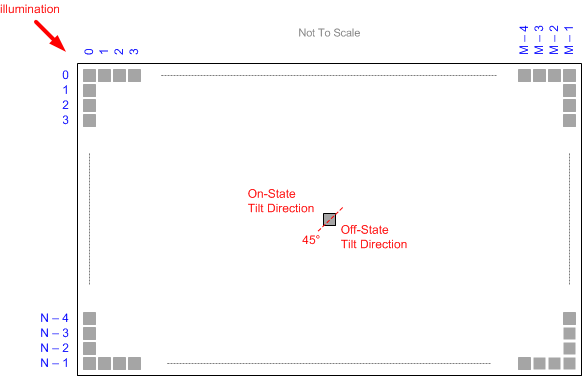JAJSGT9G April 2010 – January 2019 DLP5500
PRODUCTION DATA.
- 1 特長
- 2 アプリケーション
- 3 概要
- 4 改訂履歴
- 5 概要(続き)
- 6 Pin Configuration and Functions
-
7 Specifications
- 7.1 Absolute Maximum Ratings
- 7.2 Storage Conditions
- 7.3 ESD Ratings
- 7.4 Recommended Operating Conditions
- 7.5 Thermal Information
- 7.6 Electrical Characteristics
- 7.7 Timing Requirements
- 7.8 System Mounting Interface Loads
- 7.9 Micromirror Array Physical Characteristics
- 7.10 Micromirror Array Optical Characteristics
- 7.11 Window Characteristics
- 7.12 Chipset Component Usage Specification
- 8 Detailed Description
- 9 Application and Implementation
- 10Power Supply Recommendations
- 11Layout
- 12デバイスおよびドキュメントのサポート
- 13メカニカル、パッケージ、および注文情報
パッケージ・オプション
デバイスごとのパッケージ図は、PDF版データシートをご参照ください。
メカニカル・データ(パッケージ|ピン)
- FYA|149
サーマルパッド・メカニカル・データ
発注情報
7.10 Micromirror Array Optical Characteristics
TI assumes no responsibility for end-equipment optical performance. Achieving the desired end-equipment optical performance involves making trade-off’s between numerous component and system design parameters. See the Application Notes for additional details, considerations, and guidelines: DLP System Optics Application Report (DLPA022).
| PARAMETER | CONDITIONS | MIN | NOM | MAX | UNIT |
|---|---|---|---|---|---|
| Micromirror tilt angle, a | DMD parked state(1)(2)(3), see Figure 15 | 0 | degrees | ||
| DMD landed state(1)(4)(5), see Figure 15 | 12 | ||||
| Micromirror tilt angle variation, b(1)(4)(6)(7)(8) | See Figure 15 | –1 | 1 | degrees | |
| Micromirror Cross Over Time(10) | 16 | 22 | µs | ||
| Micromirror Switching Time(11) | 140 | µs | |||
| Non Operating micromirrors(12) | Non-adjacent micromirrors | 10 | micromirrors | ||
| Adjacent micromirrors | 0 | ||||
| Orientation of the micromirror axis-of-rotation(9) | See | 44 | 45 | 46 | degrees |
| Micromirror array optical efficiency(13)(14) | 420 - 700, with all micromirrors in the ON state | 68% | nm | ||
| Mirror metal specular reflectivity | 420 - 700 | 89.4% | nm |
(2) Parking the micromirror array returns all of the micromirrors to an essentially flat (0˚) state (as measured relative to the plane formed by the overall micromirror array).
(3) When the micromirror array is parked, the tilt angle of each individual micromirror is uncontrolled.
(4) Additional variation exists between the micromirror array and the package datums, as shown in the section at the end of the document.
(5) When the micromirror array is landed, the tilt angle of each individual micromirror is dictated by the binary contents of the CMOS memory cell associated with each individual micromirror. A binary value of 1 will result in a micromirror landing in an nominal angular position of +12 degrees. A binary value of 0 will result in a micromirror landing in an nominal angular position of -12 degrees.
(6) Represents the landed tilt angle variation relative to the Nominal landed tilt angle.
(7) Represents the variation that can occur between any two individual micromirrors, located on the same device or located on different devices.
(8) For some applications, it is critical to account for the micromirror tilt angle variation in the overall System Optical Design. With some System Optical Designs, the micromirror tilt angle variations within a device may result in perceivable non-uniformities in the light field reflected from the micromirror array. With some System Optical Designs, the micromirror tilt angle variation between devices may result in colorimetry variations and/or system contrast variations.
(9) Measured relative to the package datums B and C, shown in the メカニカル、パッケージ、および注文情報 section at the end of this document.
(10) Micromirror Cross Over time is primarily a function of the natural response time of the micromirrors.
(11) Micromirror switching is controlled and coordinated by the DLPC200 (See DLPS014) and DLPA200 (See DLPS015). Nominal Switching time depends on the system implementation and represents the time for the entire micromirror array to be refreshed.
(12) Non-operating micromirror is defined as a micromirror that is unable to transition nominally from the -12 degree position to +12 degree or vice versa.
(13) The minimum or maximum DMD optical efficiency observed in a specific application depends on numerous application-specific design variables, such as but not limited to:
- Illumination wavelength, bandwidth or line-width, degree of coherence
- Illumination angle, plus angle tolerance
- Illumination and projection aperture size, and location in the system optical path
- IIlumination overfill of the DMD micromirror array
- Aberrations present in the illumination source and/or path
- Aberrations present in the projection path
- Visible illumination (420 nm – 700 nm)
- Input illumination optical axis oriented at 24° relative to the window normal
- Projection optical axis oriented at 0° relative to the window normal
- f/3.0 illumination aperture
- f/2.4 projection aperture
- Micromirror array fill factor: nominally 92%
- Micromirror array diffraction efficiency: nominally 86%
- Micromirror surface reflectivity: nominally 88%
- Window transmission: nominally 97% (single pass, through two surface transitions)
(14) Does not account for the effect of micromirror switching duty cycle, which is application dependant. Micromirror switching duty cycle represents the percentage of time that the micromirror is actually reflecting light from the optical illumination path to the optical projection path. This duty cycle depends on the illumination aperture size, the projection aperture size, and the micromirror array update rate.

Refer to section Micromirror Array Physical Characteristics table for M, N, and P specifications.
Figure 12. Micromirror Landed Orientation and Tilt